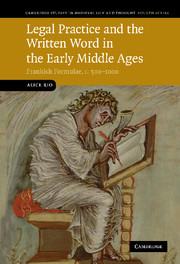Book contents
- Frontmatter
- Contents
- List of tables
- Acknowledgements
- List of abbreviations
- INTRODUCTION
- Part I Formulae, Charters and the Written Word
- Part II Inventory of the Evidence
- Part III Formulae as a Historical Source: Limits and Possibilities
- 5 DATING FORMULAE
- 6 LOCAL CONTEXT AND DIFFUSION
- 7 FROM LATE ANTIQUE NOTARIES TO ECCLESIASTICAL SCRIBES: WHEN, WHERE AND WHY FORMULARIES SURVIVE
- 8 FORMULAE AND WRITTEN LAW
- 9 A METHODOLOGICAL TEST-CASE: SLAVERY AND UNFREEDOM IN THE FORMULARIES
- CONCLUSION
- Appendix A handlist of manuscripts
- Bibliography
- Index
- Manuscript Index
7 - FROM LATE ANTIQUE NOTARIES TO ECCLESIASTICAL SCRIBES: WHEN, WHERE AND WHY FORMULARIES SURVIVE
Published online by Cambridge University Press: 14 August 2009
- Frontmatter
- Contents
- List of tables
- Acknowledgements
- List of abbreviations
- INTRODUCTION
- Part I Formulae, Charters and the Written Word
- Part II Inventory of the Evidence
- Part III Formulae as a Historical Source: Limits and Possibilities
- 5 DATING FORMULAE
- 6 LOCAL CONTEXT AND DIFFUSION
- 7 FROM LATE ANTIQUE NOTARIES TO ECCLESIASTICAL SCRIBES: WHEN, WHERE AND WHY FORMULARIES SURVIVE
- 8 FORMULAE AND WRITTEN LAW
- 9 A METHODOLOGICAL TEST-CASE: SLAVERY AND UNFREEDOM IN THE FORMULARIES
- CONCLUSION
- Appendix A handlist of manuscripts
- Bibliography
- Index
- Manuscript Index
Summary
The main argument of the previous chapters has been that sensitivity to scribal intentions offers a more positive way of looking at these texts than the quest for the urtext. This creates another set of essential questions: who exactly were these scribes, and who did they work for? If the roots of these texts are to be found in late antique notarial practices, then why do we not have any Roman examples of such collections? Why is there no manuscript evidence for them surviving from the Merovingian period? Why did they stop being copied after the tenth century? And why are they found in northern Francia, but hardly ever in the south? In short, when, where, why and by whom were such models needed, and what were the conditions necessary for their survival?
There is no evidence that formularies were ever compiled as a result of royal or imperial initiative. As we have seen, the case for the Marculf collection having been compiled in connection with a Merovingian royal chancery has been vastly overstated. Even during the heyday of what is generally referred to as the Carolingian renaissance, formularies do not appear ever to have been a centrally driven concern: the Formulae Imperiales in Paris BnF lat. 2718 are the collection with the closest association with the imperial chancery, but there is no suggestion that the manuscript was intended as anything more than a private notebook; indeed, this collection seems to have circulated rather less widely than some formularies created for local purposes in individual monasteries.
- Type
- Chapter
- Information
- Legal Practice and the Written Word in the Early Middle AgesFrankish Formulae, c.500–1000, pp. 187 - 197Publisher: Cambridge University PressPrint publication year: 2009



